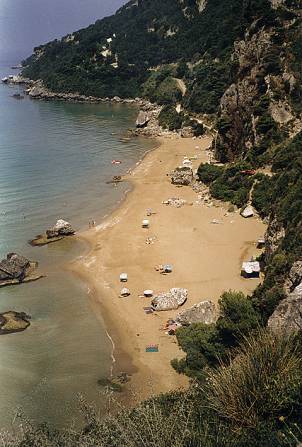 Nanoparticles (NPs) demonstrate promising properties as therapeutic carriers to efficiently deliver drug molecules into diseased cells. The surfaces of NPs are usually grafted with polyethylene glycol (PEG) polymers, during so-called PEGylation, to improve water solubility, avoid aggregation, and prevent opsonization during blood circulation. The interplay between grafting density σp and grafted PEG polymerization degree N makes cellular uptake of PEGylated NPs distinct from that of bare NPs. To understand the role played by grafted PEG polymers, we study the endocytosis of 8 nm sized PEGylated NPs with different σp and N through large scale dissipative particle dynamics (DPD) simulations. The free energy change Fpolymer of grafted PEG polymers, before and after endocytosis, is identified to have an effect which is comparable to, or even larger than, the bending energy of the membrane during endocytosis. Based on self-consistent field theory Fpolymer is found to be dependent on both σp and N. By incorporating Fpolymer, the critical ligand-receptor binding strength for PEGylated NPs to be internalized can be correctly predicted by a simple analytical equation. Without considering Fpolymer, it turns out impossible to predict whether the PEGylated NPs will be delivered into the diseased cells. These simulation results and theoretical analysis not only provide new insights into the endocytosis process of PEGylated NPs, but also shed light on the underlying physical mechanisms, which can be utilized for designing efficient PEGylated NP-based therapeutic carriers with improved cellular targeting and uptake.
for LaTeX users @article{YLi2014-35,
author = {Y. Li and M. Kr\"oger and W. K. Liu},
title = {Endocytosis of PEGylated nanoparticles accompanied by structural changes of the grafted polyethylene glycol},
journal = {Biomaterials},
volume = {35},
pages = {8467-8478},
year = {2014}
}
\bibitem{YLi2014-35} Y. Li, M. Kr\"oger, W.K. Liu,
Endocytosis of PEGylated nanoparticles accompanied by structural changes of the grafted polyethylene glycol,
Biomaterials {\bf 35} (2014) 8467-8478.YLi2014-35
Y. Li, M. Kr\"oger, W.K. Liu
Endocytosis of PEGylated nanoparticles accompanied by structural changes of the grafted polyethylene glycol
Biomaterials,35,2014,8467-8478 |






